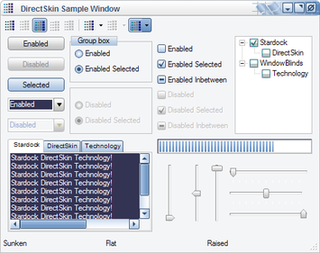Related Research Articles
The Windows API, informally WinAPI, is Microsoft's core set of application programming interfaces (APIs) available in the Microsoft Windows operating systems. The name Windows API collectively refers to several different platform implementations that are often referred to by their own names ; see the versions section. Almost all Windows programs interact with the Windows API. On the Windows NT line of operating systems, a small number use the Native API.

ActiveX is a deprecated software framework created by Microsoft that adapts its earlier Component Object Model (COM) and Object Linking and Embedding (OLE) technologies for content downloaded from a network, particularly from the World Wide Web. Microsoft introduced ActiveX in 1996. In principle, ActiveX is not dependent on Microsoft Windows operating systems, but in practice, most ActiveX controls only run on Windows. Most also require the client to be running on an x86-based computer because ActiveX controls contain compiled code.

Visual Basic .NET (VB.NET) is a multi-paradigm, object-oriented programming language, implemented on the .NET Framework. Microsoft launched VB.NET in 2002 as the successor to its original Visual Basic language. Although the ".NET" portion of the name was dropped in 2005, this article uses "Visual Basic [.NET]" to refer to all Visual Basic languages released since 2002, in order to distinguish between them and the classic Visual Basic. Along with Visual C#, it is one of the two main languages targeting the .NET framework. As of March 11th, 2020, Microsoft announced that evolution of the VB.NET language has concluded.

Microsoft XNA is a freeware set of tools with a managed runtime environment that Microsoft developed to facilitate video game development. XNA is based on .NET Framework, with versions that run on Windows and Xbox 360. XNA Game Studio can help develop XNA games. The XNA toolset was announced on March 24, 2004, at the Game Developers Conference in San Jose, California. A first Community Technology Preview of XNA Build was released on March 14, 2006.
ASP.NET is an open-source, server-side web-application framework designed for web development to produce dynamic web pages. It was developed by Microsoft to allow programmers to build dynamic web sites, applications and services.
The Internet Server Application Programming Interface (ISAPI) is an N-tier API of Internet Information Services (IIS), Microsoft's collection of Windows-based web server services. The most prominent application of IIS and ISAPI is Microsoft's web server.

SharpDevelop is a discontinued free and open source integrated development environment (IDE) for the .NET Framework, Mono, Gtk# and Glade# platforms. It supports development in C#, Visual Basic .NET, Boo, F#, IronPython and IronRuby programming languages.
DNN is a web content management system and web application framework based on Microsoft .NET. The DNN Platform Edition is open source.

DirectSkin is a software component that is used by software developers to add skinning capability to their applications, which may or may not be exposed to end-users. It is made by Stardock, and is derived from the WindowBlinds component of their software subscription package, Object Desktop. Being implemented as an ActiveX/COM component, it may be used by any COM-capable language, including Visual Basic, VB.NET, C#, C++ and Delphi.

C# is a general-purpose, multi-paradigm programming language encompassing static typing, strong typing, lexically scoped, imperative, declarative, functional, generic, object-oriented (class-based), and component-oriented programming disciplines.
Microsoft SQL Server Analysis Services, SSAS, is an online analytical processing (OLAP) and data mining tool in Microsoft SQL Server. SSAS is used as a tool by organizations to analyze and make sense of information possibly spread out across multiple databases, or in disparate tables or files. Microsoft has included a number of services in SQL Server related to business intelligence and data warehousing. These services include Integration Services, Reporting Services and Analysis Services. Analysis Services includes a group of OLAP and data mining capabilities and comes in two flavors - Multidimensional and Tabular.
In Microsoft Windows applications programming, OLE Automation is an inter-process communication mechanism created by Microsoft. It is based on a subset of Component Object Model (COM) that was intended for use by scripting languages – originally Visual Basic – but now is used by several languages on Windows. All automation objects are required to implement the IDispatch interface. It provides an infrastructure whereby applications called automation controllers can access and manipulate shared automation objects that are exported by other applications. It supersedes Dynamic Data Exchange (DDE), an older mechanism for applications to control one another. As with DDE, in OLE Automation the automation controller is the "client" and the application exporting the automation objects is the "server".

Visual Basic is a third-generation event-driven programming language from Microsoft known for its Component Object Model (COM) programming model first released in 1991 and declared legacy during 2008. Microsoft intended Visual Basic to be relatively easy to learn and use. Visual Basic was derived from BASIC and enables the rapid application development (RAD) of graphical user interface (GUI) applications, access to databases using Data Access Objects, Remote Data Objects, or ActiveX Data Objects, and creation of ActiveX controls and objects.

Microsoft Visual Studio is an integrated development environment (IDE) from Microsoft. It is used to develop computer programs, as well as websites, web apps, web services and mobile apps. Visual Studio uses Microsoft software development platforms such as Windows API, Windows Forms, Windows Presentation Foundation, Windows Store and Microsoft Silverlight. It can produce both native code and managed code.

.NET Framework is a software framework developed by Microsoft that runs primarily on Microsoft Windows. It includes a large class library called Framework Class Library (FCL) and provides language interoperability across several programming languages. Programs written for .NET Framework execute in a software environment named the Common Language Runtime (CLR). The CLR is an application virtual machine that provides services such as security, memory management, and exception handling. As such, computer code written using .NET Framework is called "managed code". FCL and CLR together constitute the .NET Framework.

Microsoft started development on the .NET Framework in the late 1990s originally under the name of Next Generation Windows Services (NGWS). By late 2001 the first beta versions of .NET 1.0 were released. The first version of .NET Framework was released on 13 February 2002, bringing managed code to Windows NT 4.0, 98, 2000, ME and XP.
Windows Runtime (WinRT) is a platform-agnostic application and component architecture first introduced in Windows 8 and Windows Server 2012 in 2012. WinRT supports development in C++/WinRT, C++/CX, Rust/WinRT, JavaScript-TypeScript, and CLI languages such as C# and Visual Basic .NET (VB.NET). WinRT applications natively support both the x86 and ARM processors however native apps need to be separately compiled for each architecture, and may run inside a sandboxed environment to allow greater security and stability. WinRT components are designed with interoperability among multiple languages and APIs in mind, including native, managed and scripting languages.

.NET is a free and open-source, managed computer software framework for Windows, Linux, and macOS operating systems. It is a cross-platform successor to .NET Framework. The project is primarily developed by Microsoft employees by way of the .NET Foundation, and released under the MIT License.

PeachPie is an open-source PHP language compiler and runtime for .NET and .NET Core frameworks. It is built on top of the Microsoft Roslyn compiler platform and is based on the first-generation Phalanger project. PeachPie compiles source code written in PHP to CIL byte-code. PeachPie takes advantage of the JIT compiler component of the .NET Framework in order to handle the beginning of the compilation process. Its purpose is not to generate or optimize native code, but rather to compile PHP scripts into .NET assemblies containing CIL code and meta-data. In July 2017, the project became a member of the .NET Foundation.
References
This biography of a living person needs additional citations for verification .(November 2009) (Learn how and when to remove this template message) |
| | This biographical article relating to a computer specialist is a stub. You can help Wikipedia by expanding it. |